
Pell City artist paints ornament for
national Christmas tree display
Story by Leigh Pritchett
Photos by Wallace Bromberg Jr.
Submitted photos
When the 95th annual National Christmas Tree Lighting display opened in Washington, D.C., in December, a little piece of Pell City was among the decorations.
That is because local artist Buddy Spradley had painted one of the ornaments.
Spradley’s work and that of 13 other artists from North and Central Alabama were selected to help decorate the state’s tree in President’s Park. According to the National Park Service, 56 Christmas trees – one for each of the 50 states, the District of Columbia and the U.S. territories – showed their splendor in President’s Park from Dec. 1, 2017, through Jan. 1, 2018.
The effort to provide the dozen ornaments for the Alabama tree was coordinated by the Alabama State Council on the Arts and locally by Heritage Hall Museum in Talladega.
 “It is our honor to decorate our home state tree and help the nation celebrate the holidays in one of our most recognizable parks,” said Valerie White, director of Heritage Hall Museum. “We are all excited to be part of the ‘America Celebrates’ display. It gives us an opportunity to show our pride in our state’s artistic talent, stunning natural wonders and vibrant cultural heritage.”
“It is our honor to decorate our home state tree and help the nation celebrate the holidays in one of our most recognizable parks,” said Valerie White, director of Heritage Hall Museum. “We are all excited to be part of the ‘America Celebrates’ display. It gives us an opportunity to show our pride in our state’s artistic talent, stunning natural wonders and vibrant cultural heritage.”
Spradley was excited too, in addition to “speechless, nervous, … thankful, honored.” He said he is “proud to represent Alabama to the U.S. in that way, through art.”
Spradley’s ornament depicts two waterfalls at Little River Canyon in Fort Payne. He chose Grace Falls as the main focus, with another Little River waterfall on the opposite side of the ornament.
Little River Canyon “has a special feeling to me,” he said. “(I’ve) always had a personal closeness to that area.”
Many times through the years, he has gone to Little River Canyon with his dad, nationally known watercolor artist Wayne Spradley of Pell City. The elder Spradley has painted Grace Falls in the past, a fact that influenced his son’s decision to feature it on the ornament.
“Now, he and I both have done Grace Falls,” said Buddy Spradley.
Although Spradley had not previously painted a spherical piece, he was able to complete the acrylic project in about two weeks during September 2017. He did confess, however, that holding the ornament and painting it at the same time presented quite a challenge. But duct tape saved the day. Spradley found that the center hole of a roll of duct tape made the perfect cradle for holding the ornament steady while he painted on it.
An artist’s early start
Spradley’s chance to help decorate a national Christmas tree through art really can be traced back 45 years when he won his first art competition at age 8. That piece was an abstract.
He grew up around art, watching his dad create wildlife scenes and landscapes that would gain national acclaim. In the early 1980s, his dad produced the artwork for the Alabama Waterfowl Stamp.
After Buddy Spradley graduated from Pell City High School, he put art aside and instead earned a mortuary science and forensics degree. For eight years, he worked at Kilgroe Funeral Home, with his uncle and aunt, Sonny (now deceased) and Jane Kilgroe. From the couple, Spradley learned much about respecting, serving and helping people. “That job did teach me compassion,” he said.
It was also during those years that he felt a calling to teach. To prepare for the career change, he studied graphic art and anthropology at Jacksonville State University, and then art education at the University of Alabama.
For two years in Anniston, followed by 18-plus years in Pell City Schools, Spradley taught art to “thousands of kids.”
During the years of teaching, his art mostly consisted of pieces he painted as classroom demonstrations for the students. His focus was on educating and encouraging his students, rather than producing his own pieces.
He called the job a “blessing,” saying he went to school each day with a smile and left with a smile. The time in between was spent trying to instill in every child a sense of success and accomplishment.
Dr. Micheal Barber, superintendent of Pell City Schools, described Spradley as a “wonderful artist and wonderful teacher. … He brings life into art.”
Barber said Spradley incorporated into art class what the students were learning in history, science and other subjects.
Spradley is retired from the classroom now and greatly misses teaching students. He still feels a deep sense of responsibility toward them.
“Teaching school was such an important, big part of my life. … You’ve got to behave yourself and be a good role model … in and out of school,” Spradley said. “Even though I’m retired, I feel like I’m still responsible for making a good impression.”
The Christmas tree in his living room at the time of Discover’s visit with Spradley gave evidence of the impact he has had upon many young lives. Decorations given by past students adorned the tree from top to bottom.
It is not uncommon for former students who are now adults to tell him, “I’ve still got the Christmas tree we did in art, and I put it up on the mantle every year.”
His own heritage of art has become one of his treasures. In fact, the art table he uses is the very first one that his father had … back in 1954. He also has, as a keepsake, a sizable stack of his dad’s art demonstration pieces.
Prior to retirement, Spradley’s life journey already had taken several significant turns. Among them were an emergency triple bypass at age 38 and the death of his mother, Pat, from complications related to Alzheimer’s disease. Then, in September 2015, his journey took a path that made retiring necessary. Spradley was told he had gastric and esophageal cancer that was stage 3 – bordering on stage 4.
“I had less than a 9 percent chance of survival,” Spradley said. “… But I knew I was (going to make it). … Thank God, I had some of the most professional, caring doctors. They saved my life. My surgeon prayed with me before surgery. … They cared about my wellbeing and I am so thankful for that. I never would have survived without my family and my friends. Never.”
Spradley said his dad had always been “my rock,” but was even more so during that time. Also, aunts Jane Kilgroe and Jean Phillips were very caring and continue to be.
The chemotherapy treatment, which lasted a year, caused nausea, fatigue, neuropathy in his hands and loss of appetite. The neuropathy prevented Spradley from holding a paintbrush.
His determined dad devised a means for his son to return to painting. It involved inserting the brush handle into a small tube and taping the tube to his son’s finger. With such a setup, Buddy Spradley did not have to hold the brush, he only had to point his finger to paint.
It worked well and Buddy Spradley again was creating wildlife and landscape scenes and an occasional abstract. Painting, he discovered, helped to overcome the neuropathy.
On one particular day during the battle with cancer, Spradley stood at his kitchen window, looked out and prayed. He said he was about to start the next part of his life and asked God what He wanted Spradley to do.
Very soon, things started happening.
Almost overnight, Spradley felt a stronger commitment to art. He became “completely engulfed in my painting.”
Also, his skill reached a new level.
Wayne Spradley noticed a marked difference in his son’s artwork, especially in draftsmanship and execution. He saw his son’s abilities draw ever so close to perfection.
Then, came the invitation for Buddy Spradley to paint an ornament for a Christmas tree in the nation’s capitol.
“It was so unexpected,” Spradley said. “And it all goes back to when I was standing in that window and was asking for guidance for the second half of my life.” When God opens doors, Spradley said, “(you get) to do things you didn’t think you could do.”
Wayne Spradley was thrilled that his son was chosen for the honor. “I was proud of him,” he said. “I encouraged him as much as I could.”
Buddy Spradley could also imagine his mom’s voice telling him she is proud of him, too, just as she had done so often during his life.
In early 2018, Spradley embarked on another project – that of submitting an entry to the Alabama Waterfowl Stamp art contest. The painting he has in mind to do will be painstaking, considering that each feather of the ducks will have to be done individually. Yet, he looks to the challenge with the hope of being listed among the winners, just like his father is.
At times, Spradley still struggles with residual effects of cancer treatment. “It’s something you learn to live with and not let it stop you. (You) have faith that the Good Lord is with you, (and you) try to make a difference in every day.”
He said that experiencing cancer has changed life entirely. He has learned to see God’s miracles in everything. “ ‘Only the Good Lord can make beautiful things,’ ” Spradley remarked, recalling what he had heard his mother say so frequently. “I carry that quote with me daily.”
He cherishes family, enjoys friendships, studies with an insatiable hunger for knowledge, paints with conviction and appreciates the preciousness of life.
“I’m thankful for every day.”
Buddy Spradley’s artwork is available through his Facebook page and at Pell City Coffee Company. Visit www.heritagehallmuseum.org/community to see Buddy Spradley’s ornament, as well as those produced by the other 13 North and Central Alabama artists. (A note of interest: Three of the other 13 artists are current students of Wayne Spradley.)















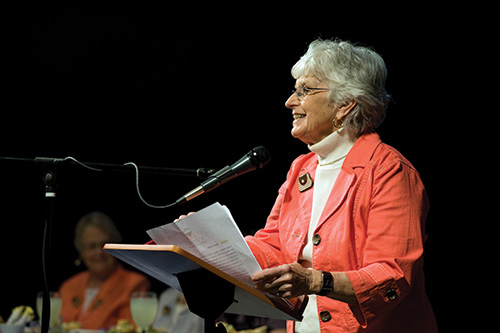
 “She loved people and loved making people happy,” the Rev. Shafer said of her mom.
“She loved people and loved making people happy,” the Rev. Shafer said of her mom.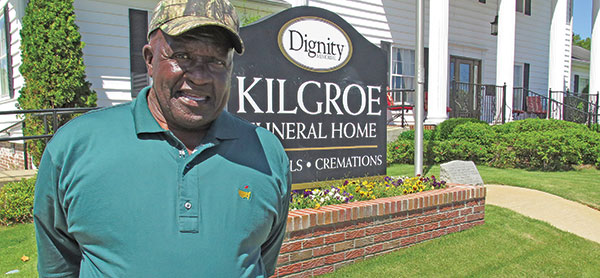
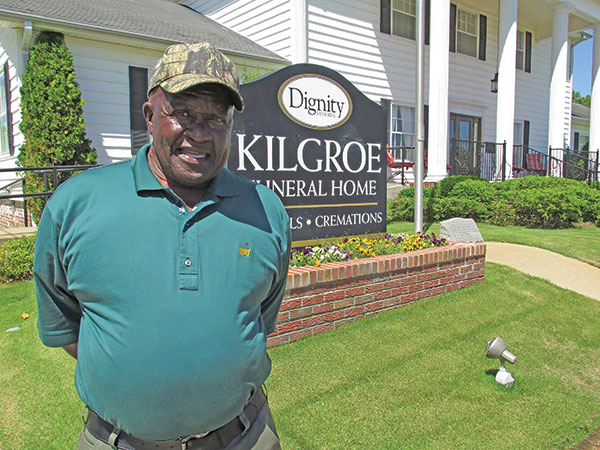
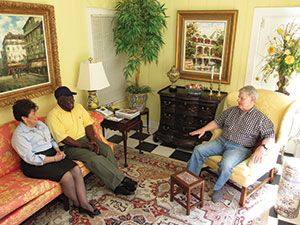 Harry Charles was 9 when his father, Blois McCoy, died at the age of 37, leaving his mother, Josephine McCoy, with eight children to raise. Vowing to aid his mother, Harry Charles stepped up to help for the first of countless times, going to work doing odd jobs around town and at the Lee Motel, where his mother was employed.A 12-year-old Harry Charles was cutting grass at the motel when a friend of the Kilgroe family asked him if he’d like another job. “I said, ‘Yes ma’am.’ That was 1962, and I’ve been here ever since,” says Harry Charles.
Harry Charles was 9 when his father, Blois McCoy, died at the age of 37, leaving his mother, Josephine McCoy, with eight children to raise. Vowing to aid his mother, Harry Charles stepped up to help for the first of countless times, going to work doing odd jobs around town and at the Lee Motel, where his mother was employed.A 12-year-old Harry Charles was cutting grass at the motel when a friend of the Kilgroe family asked him if he’d like another job. “I said, ‘Yes ma’am.’ That was 1962, and I’ve been here ever since,” says Harry Charles.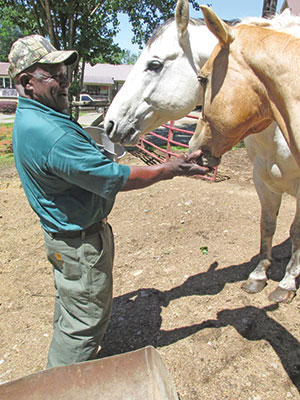 He grew up side by side with Sonny Kilgroe, who was a few years older and taught Harry how to do most every job at the funeral home. “We were always working together. He helped me, and I learned a lot. Mr. Sonny was like my brother,” Harry says. Sonny died in 2015. “I’ll never stop missing him.”
He grew up side by side with Sonny Kilgroe, who was a few years older and taught Harry how to do most every job at the funeral home. “We were always working together. He helped me, and I learned a lot. Mr. Sonny was like my brother,” Harry says. Sonny died in 2015. “I’ll never stop missing him.”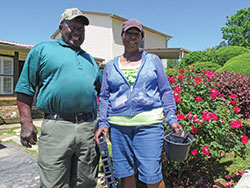 Jane Kilgroe recalls that when she and Sonny were about to get married, Sonny was so nervous that Harry Charles packed Sonny’s suitcase for the honeymoon. “That’s how close they were,” Jane says.
Jane Kilgroe recalls that when she and Sonny were about to get married, Sonny was so nervous that Harry Charles packed Sonny’s suitcase for the honeymoon. “That’s how close they were,” Jane says.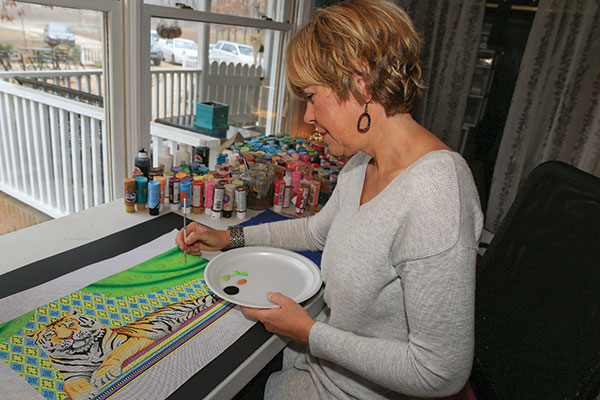
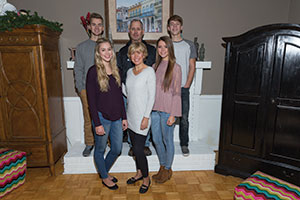 Marie and her parents lived with grandparents in the countryside in a home without indoor plumbing.
Marie and her parents lived with grandparents in the countryside in a home without indoor plumbing.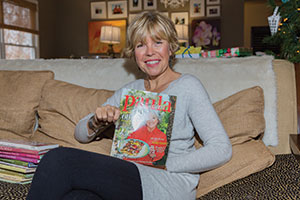 From the large floral acrylic on canvas that accents her dining room to the vibrant needlepoint pillow she had just finished, all her pieces show her penchant and flare for color.
From the large floral acrylic on canvas that accents her dining room to the vibrant needlepoint pillow she had just finished, all her pieces show her penchant and flare for color.
 In Tuscaloosa, he pitched the idea for The Crooners to then program director Roger Duvall. “I loved Sinatra and the crooners, of course, and fortunately, he went for it,” Owen recalled.
In Tuscaloosa, he pitched the idea for The Crooners to then program director Roger Duvall. “I loved Sinatra and the crooners, of course, and fortunately, he went for it,” Owen recalled.
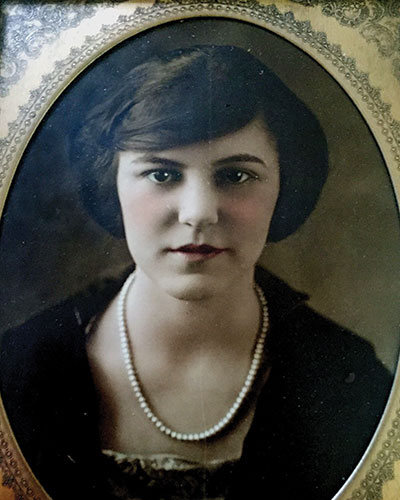 Story and photos by Jerry Smith
Story and photos by Jerry Smith A lover of all things historic, she could not bear to see this fine old structure demolished. Reluctant to put themselves at odds with the indomitable Mrs. Crow, the County Commission agreed that she could have the old building provided she moved it somewhere else, and soon.
A lover of all things historic, she could not bear to see this fine old structure demolished. Reluctant to put themselves at odds with the indomitable Mrs. Crow, the County Commission agreed that she could have the old building provided she moved it somewhere else, and soon.